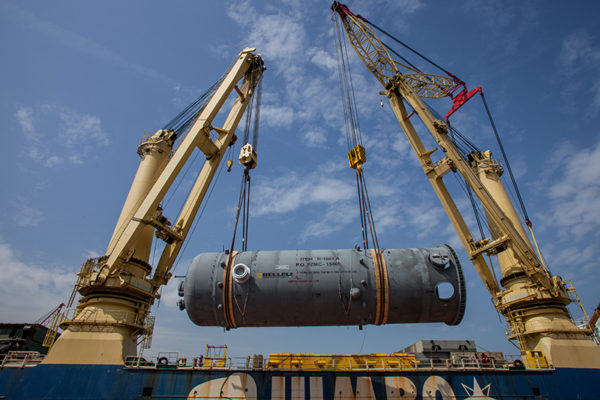Gas Monetization
 Methanol, a light, volatile, colorless gas, is mainly produced industrially by hydrogenation of carbon monoxide gas and hydrogen in the presence of a catalyst. Its principal uses are in organic synthesis, as a fuel, solvent, and antifreeze.
Methanol, a light, volatile, colorless gas, is mainly produced industrially by hydrogenation of carbon monoxide gas and hydrogen in the presence of a catalyst. Its principal uses are in organic synthesis, as a fuel, solvent, and antifreeze.
Belleli builds main critical process equipment for several industrial Methanol-production processes and is licensed supplier for the main epc.
Type of equipment:
- Water Cooled Methanol Reactors
- Gas Cooled Methanol Reactors
Units delivered: more than 60 units since 1980
Max Weight: 475 tons
Max dimension:
- 6.400 tubes
- 18.000 mm length
- 5.470 mm diam
- 155 mm thk
Materials:
- Carbon Steel
- Low alloy steel
- Duplex stainless steel
Process Licensors: Air Liquide-Lurgi, Toyo, Davy Process Technology
 Ethylene oxide (EtO) is produced in large volumes and is primarily used as an intermediate in the production of several industrial chemicals, the most notable of which is ethylene glycol.
Ethylene oxide (EtO) is produced in large volumes and is primarily used as an intermediate in the production of several industrial chemicals, the most notable of which is ethylene glycol.
Its production process involves tubular Reactors due to the required steady-state flow, one of the main products that belongs to Belleli's wide construction capabilities.
Units: > 10 units built since 1989
Max weight: 888 tons
Maximum Dimensions:
- 21.200 mm length
- 6.130 mm diam
- 144 mm thk
Materials: Carbon Steel, Micro-Alloyed (high strenght) steel, Low Alloy steel, 300 Series and Duplex Stainless steel
Process Licensors: Shell, KBR, Basf, Scientific Design, Lurgi-Air Liquide, Toyo
 Gas to liquids (GTL) is a refinery process to convert natural gas or other gaseous hydrocarbons into longer-chain hydrocarbons, such as gasoline or diesel fuel. Methane-rich gases are converted into liquid synthetic fuels.
Gas to liquids (GTL) is a refinery process to convert natural gas or other gaseous hydrocarbons into longer-chain hydrocarbons, such as gasoline or diesel fuel. Methane-rich gases are converted into liquid synthetic fuels.
These extremely complex reactors need to be carefully designed, often through finite elements analysis.
Max weight: 1125 tons
Maximum Dimensions:
- Reactor Length: 30.000 mm
- Shell Diameter: 7.200 mm
- N. Of Tubes: 29.400
- 193 mm thk
Materials: Carbon Steel, Micro-Alloyed (high strength) steel, Low Alloy steel, 300 Series and Duplex Stainless steel
Process Licensors: Shell, KBR, Basf, Scientific Design, Lurgi-Air Liquide, Toyo

Coal gasification is the process of producing syngas from coal and water, air and/or oxygen. In current practice, large-scale coal gasification installations are primarily for electricity generation, or for production of chemical feedstocks. The hydrogen obtained from coal gasification can be used for various purposes such as making ammonia, powering a hydrogen economy, or upgrading fossil fuels. Alternatively, coal-derived syngas can be converted into transportation fuels such as gasoline and diesel through additional treatment, or into methanol which itself can be used as transportation fuel or fuel additive, or which can be converted into gasoline.
Coal Gasification critical process equipment needs to withstand extremely high temperature with high resistance steel, thus requiring specialized craftmanship to be handled and welded.
Belleli partnered with important companies to further develop advanced design for this equipment.
 Ethylbenzene (EB) is a precursor of styrene monomer (SM), which is the basic building block for the production of the polystyrene and other styrenic resins used in consumer goods. Most of EB produced is used as an intermediate of production of styrene, it is also used for anti-knocking agent in gasoline, rubber adhesives, paint, solvent in inks etc.
Ethylbenzene (EB) is a precursor of styrene monomer (SM), which is the basic building block for the production of the polystyrene and other styrenic resins used in consumer goods. Most of EB produced is used as an intermediate of production of styrene, it is also used for anti-knocking agent in gasoline, rubber adhesives, paint, solvent in inks etc.
One of the most important equipment for EB-SM plants is Combined Heat Exchanger design for a controlled cooling during the process, and Belleli is highly skilled for its fabrication.
Type of equipment:
- Combined Heat Exchanger
- Primary Reactor
- Secondary Reactor
Maximum Weight: 470.000 kg
Process Licensors: BASF

 Italiano
Italiano